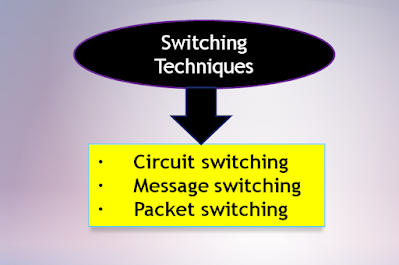What is switching and Types of switching techniques in Data communication | TheSmartLearn
What is switching and Types of Switching Techniques in Data communication
A switched network is an interconnected network of nodes known as switches. The switches are either software or hardware devices capable of creating permanent connections between two devices.
The technique that can determine how connections are made between the devices and how data movement is handled is switching.
- Circuit switching
- Message switching
- Packet switching
CIRCUIT SWITCHING
The circuit switching path or route is a dedicated path with dedicated resources on both ends. A telephone system is an example of circuit-switching communications. It provides a fixed speed of transmission. The circuit could be created using wire, copper optical fibers, radio links, satellite connections, or any combination of these mediums.
Applications that make use of circuit switching might require three phases:
- Establishing a circuit
- Transfer the data
- Disconnect the circuit
ADVANTAGES
- The circuit is formed, there is an immediate connection between the communications entities, and the network is entirely transparent to the entities involved.
- Information flows seamlessly across the circuit from one side to the other.
DISADVANTAGES
- The time spent establishing the connection. It establishes that the destination is available to receive communication.
- The connectivity is dedicated to the duration of the connection even if there is no data being transferred. Therefore, the utilization of the connectivity isn't very high.
MESSAGE SWITCHING
Message switching can be a viable alternative to switching circuits in communications. In message switching, direct physical connections are not made between the receiver and the sender before data transmission. The entire message is considered a data unit and wholly transferred with message switching.
A switch working on message switching first receives the complete message and buffers it until the resources are ready to move this message onto the subsequent hop. If the hop following isn't equipped with enough resources to handle an enormous message, the message is kept for a while, and the switch will wait.
Message switching is the data's logical unit that is then sent sequentially. Each unit is assigned an address, and an address unit is created and then sent to the address for storage. Firstly, the connection between receivers is created during circuit switching communications; however, it is not necessary to switch messages.
ADVANTAGES
- In the case of message switching, the line's efficiency is higher and simultaneous accessibility of the sender and recipient is unnecessary.
- The rate of message switching is exceptionally minimal due to the store-and-forward technique, which waits for available resources.
- Each switch on the transmission path requires storage space to hold the whole message.
DISADVANTAGES
- There is no assurance that the complete message was delivered to the recipient without errors. Switching messages includes Telegrams emails, computer files, transaction queries, and their processing.
- In message switching, the simultaneous availability of the sender and receiver is not required as in circuit switching.
PACKET SWITCHING
With packet switching, the data to be sent are split into small units, referred to as the packet. Each packet comprises data, the packet's address, a packet number, and the number of the last packet. In other words, when you use packet switching, the data to be sent are divided into smaller units, referred to as packets.
Each data packet includes these details in the header section:
- Address of the source
- Address of destination
- The total amount of packets
- Sequence number to reassemble
The packet may be delivered individually and with any number of orders. But, they must be combined in the correct order at the reception point. The data packet sent by a user or node to another node or user may travel in different ways to reach their destination.
The packet is transmitted via a virtual circuit; the virtual circuit functions as a temporary connection. The station sending and receiving communications is based on specific rules that include the packet flow control, size, and error control. Transforming a packet requires bandwidth to move the packet into an intermediate channel. It allows multiple messages to interleave over the same network medium simultaneously at the same time.
ADVANTAGES
- In the case of packet switching, the benefits and advantages of the circuit and message switching are combined.
- The primary benefit of packet switching is that it can be sent via any route available in the network.
DISADVANTAGE
- There is a deficiency of security protocols to protect data packets transmitted.

